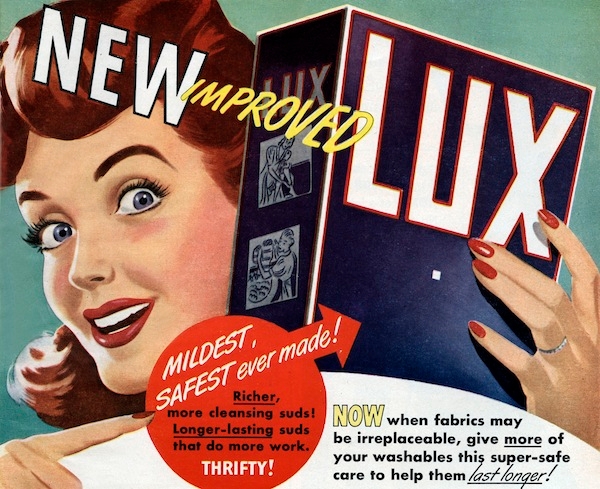Showering the other day, I noticed a visitor had left his shampoo behind. Going through the familiar ablutions I stared glassily, half-focused on the immediate foreground, in the way you do when your activity requires some but not all of your attention. Vosene. The trade name started running through my mind. I repeated it to myself out loud. ‘Vosene’. What an odd title for a shampoo. It sounded cold, clinical, antiseptic, perhaps a little harsh: a nod more in the direction of hygiene than of the soft, caring, nurturing image that more recently branded hair products aim to convey.
I bet (I thought, remembering my 1950s bedroom wall poster of nuclear power stations) that Vosene is a mid-20th-century brand name. It has the ring of science about it: for in those days ‘science,’ ‘scientific’ and even ‘chemical’ were hooray-words. Science was the future, science was making our lives better, leading the way. The men in white coats were on our side. There was not that shudder that now comes with the idea of rule-by-science. Nobody would come up with the name Vosene to brand what is basically a cosmetic product today.
A similar bathroom-based reverie returned in Spain last month, in my family’s house. The toothpaste on the shelf was called Eurodont. How clearly (I thought) this marks the difference between the way we British now see the European Union, and the cachet it carries in Spain where Europe is still cool: associated with modernity, democracy, an end to isolation and the bad old days of fascist dictatorship. You wouldn’t in Britain name a toothpaste ‘Eurodont’ any more than you’d name a moisturiser ‘Euromilk’ or a toilet paper ‘Europamper’.
But even with us there was a brief period in the 1970s, before we British made up our minds that Europe was a nuisance rather than a boon, when manufacturers did prefix ‘Euro’ to their products on the supposition that this would give the brand an air of being futuristic. Nobody would suppose that now.
I awoke in the middle of the night last week and, sleepless, resumed these reflections. Windolene, Stergene, Germolene… most of these, I’m sure, mid-20th-century brands. I started leaping out of bed to write the names down — Margarine! Silkolene! Plasticine! Velveteen! What is it with this suffice ‘-ine’ or ‘-ene’? Why does it (or did it) sound so modern? In fact, ‘-ene’ just means pertaining to or related to, but it gained widespread use in scientific terminogy through its function of generating adjectival variants on root-concepts: polystyrene, pliocene, fluorine, kerosene. Anything ending in –ene/ine just sounds… well, terribly advanced.
The –enes did not have the monopoly of futuristic branding in the last century. There was a bit of a craze for ‘–on’ (the gas argon perhaps has something to answer for here), but assisted as a suffix by being the first syllable of our metropolis when prefixed with l, as in Skylon, Nylon. But there was Rayon too, and the washing powder Radion (in the days before radiation became a boo-word — and three cheers to Radox for sticking with it). Why, though, the mystique of ‘-ex’? Rolex, Durex, Spandex, Tippex, Travelex… all, and rather inexplicably, modern-sounding once; now dreadfully dated.
When the cuddlier and classier side of a product was favoured over the scientific, manufacturers added ‘-lux’: Dulux paints, Lux soap, Thermolux. What, I began to wonder, came before sci-fi as the key to modernity in trade-marking? What marked the Edwardian and interwar years?
A certain bright and cheerful jollity, I concluded, beginning again my leaps to the bedside table. And nothing indicated this better than the suffix ‘-o’. ‘Righto’, as Dad used to say. And we got Vimto, Brillo, Omo, Brasso, and the American jello. That whizzo ‘-o’ does, doesn’t it? Older readers may be able to enlighten me: one thinks of that ‘o-de-o’ refrain in Roaring Twenties songs.
Go back further (I’d been awake for hours now) and you reach an era when trade names in proprietary brands typically took the surname of the inventor or proprietor. Dr White’s Lemonade; Beechams Powders; Carter’s Little Liver Pills; Fry’s; Barclays, Coutts, Martin’s Bank; Clarks shoes; or Cadbury’s, Rowntree’s, Fox’s mints (1895).
I sense that later, in the 20th-century, naming your product after its progenitor felt distinctly passé. But it was to come back into fashion at the end of the 20th century, when in what was probably a retro way, restaurants and fashion labels started to name themselves after people again, usually (now) using Christian names as well.
Then, over the turn of the 20th/21st centuries, we had the very brief flowering of language-unspecific trade names, doubtless associated in the public mind with globalisation. It has not caught on. I nearly left Norwich Union when it renamed itself Aviva, and am still unreconciled to the ghastly faux-internationalism it implies. Amid a storm of public and media derision, the poor old Post Office had to reverse its move to being called Consignia. Such reactions may perhaps reflect a certain revulsion against globalisation, as the fruits have turned sour.
And that’s before we get onto car branding (as I did, around dawn) and how this helps us understand what different epochs have seen the car as representing. At the end of the 19th century, proprietors’ names again dominate: Rolls-Royce, Daimler, Benz, Renault, Peugeot. Next comes a move towards names connoting freedom and mobility (Rover, the Riley Pathfinder), and then an aggressive, even predatory streak soon becomes evident: Jaguar, Hillman Minx, Humber Hawk/Snipe. As one approaches our own day, though, the names, like the mode of transport, tend to become fuzzier and more workaday: the Honda Civic representing a low-point of dullness, the glamour fading.
But by now the sun was up, ideas about what the naming of products may tell us about an epoch racing through my head. Someone should write a book about this.







Comments